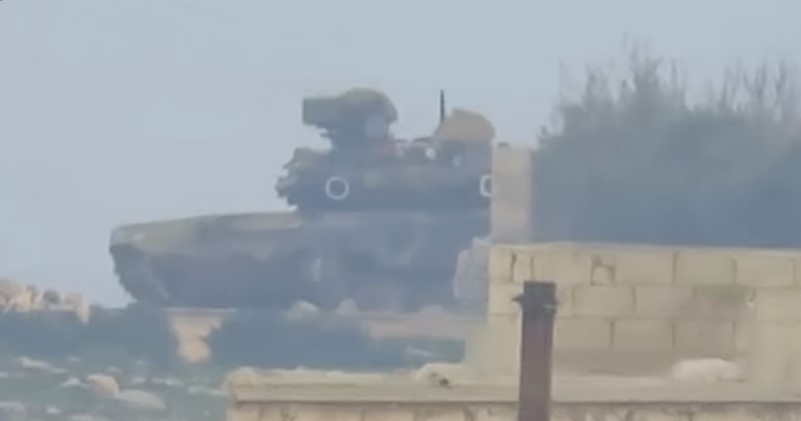
Original by Andrey Rezchikov published by Vzglyad; translation by J.Hawk
A video surfaced in the internet of a missile attack on a T-90 tank on Syria’s territory. The tank survived a hit by a US-made anti-tank missile. According to the specialists, the incident suggests the T-90s advantages over Western tanks.
The video shows the moment in which a US-made TOW ATGM strikes the T-90. The incident took place west of Aleppo, in rural areas where the SAA has been actively fighting against the Islamic State. The missile was fired by some “Desert Hawk brigade which apparently is part of the “moderate opposition” or, more specifically, to the Free Syrian Army.
“If that missile penetrated the armor, nobody inside the tank would have survived.”
Experts agree that the incident showcases the T-90’s advantages over Western tanks.
“The missile simply went off to the side”
The deputy director of Uralvagonzavod which manufactures the T-90, Vyacheslav Khalitov, notes that the video is too blurry so that it’s difficult to determine what vehicle it is, but it “closely resembles the T-90.” According to Khalitov, the video must have been composed of two parts. The first suggests that the Shtora optronic suppression system was effective because the missile “simply went off to the side.”
https://www.youtube.com/watch?v=fYOJSz1WOEg
“Shtora is part of T-90s multi-layer protection. It is a subsystem designed to protect the vehicle against flare-tracked ATGMs,” Khalitov told Vzglyad.
According to Khalitov, the T-90 also has another protective system which detects an approaching missile by detecting the illuminating laser beam, and then launches a metallic aerosol grenade which disperses the laser beam thus depriving the enemy of the ability to guide the missile or estimate range using a laser rangefinder.
Khalitov also said that the second part of the video differs from the first one–the tank’s Shtora was not switched on which allowed the missile to strike its target but “then the reactive armor suite was activated which prevented the tank from suffering serious damage and the crew was able to leave it.”
“The tank remained operational after the missile hit. Reactive armor tiles destroy munitions striking the tank before they are able to penetrate the basic armor,” Khalitov noted.
He emphasized that the T-90 is a survivable machine, which is confirmed both by testing and actual combat operations. “As long as the tank is provided with reactive armor tiles and not empty boxes, as has been known to happen, if all the defensive systems are functional and switched on, the vehicle is very survivable. Statistics of their use in combat has shown they are highly reliable and survivable, more so than their Western counterparts,” Khalitov claims.
Of course, one does have to qualify his statement by adding that a representative of the tank’s manufacturer could have hardly said anything else.
Strong armor
Colonel General Anatoliy Sitnov, Deputy Minister of Defense for Armaments, also says that the T-90s reactive armor allowed the crew to survive. “The crew survived. It means that the reactive armor worked. Had the armor been penetrated, nobody would have survived inside,” Sitnov told Vzglyad.
The modernized T-90MS tank was demonstrated three years ago. It contains a number of improvements “to satisfy potential customers.” It has a more powerful engine, a new air conditioner, thicker engine compartment armor, and a 12.7mm machine-gun in a remote-control turret mount.
Russia has been promoting that vehicle throughout the Middle East. Iran expressed interest in the T-90.
The T-90 was developed in the late 1980s and early 1990s. It entered service in 1992. It was one of the best-selling tanks between 2001 and 2010, mainly thanks to the contract with India.
After the Russian campaign in Syria began, Syrian militants obtained over a hundred ATGMs, which caused the attacking Syrian forces lose up to 10 armored vehicles a day. Videos published in October 2015 showed the rebels use US-made TOW ATGMs.
In early February, photographs appeared on the internet showing Syrian vehicles equipped with new, possibly developed with Russian assistance, defensive systems intended to protect against TOW missiles.
J.Hawk’s Comment: The T-90 in question most likely survived the attack, though one of its crewmembers, likely a Syrian army tanker who still has memories of operating early-model T-72s with thinner armor protection and often no reactive armor, likely instinctively jumped out of the tank fearing that the missile hit had scored a lethal hit which would soon result in a fire. The video also shows the Syrian tank crew in question is lacking in training–no matter how survivable the tank is, it is generally a bad idea to sit still in an exposed firing location for such a long period of time, because no tank completely invulnerable.





